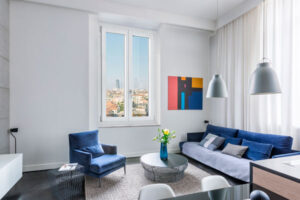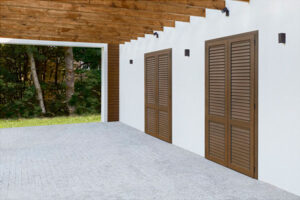Maximizethe purchase.
The comfort inside the buildings is the sum of several factors: thermal-acoustic insulation, brightness, temperature and air quality. Correctly using the fixtures you can always enjoy the proper temperature, avoid the unpleasant air in the rooms or moisture and mould problems arise. Small daily precautions, some of them already known, they will manage to maximize the purchase of new fixtures.

Airing.
The well-being inside the buildings is also determined by the quality of the air that is breathed. The presence of people, animals and plants, inside the premises, determines the increase of carbon dioxide, water vapour and dust; at the same time decreases the oxygen concentration. This creates so-called spoiled air. When the air is spoiled you may feel tired, reduced concentration or other small ailments. To restore the fair balance, it is necessary to promote air exchange and the supply of oxygen from outside, even in polluted cities. The right aeration fluctuates based on the season.
The summer ventilation
In warm weather it is advisable to open the windows in the early morning and after sunset, when the air is cooler. This operation will allow not only the air renewal but also the cooling of the house free of charge.
The winter ventilation
In the cold season there is a significant difference between the temperature inside and outside, so it takes a few minutes to completely regenerate the air. In winter it is necessary to air briefly, opening the windows 2 or 3 times at most. Opening the windows, more often than recommended, certainly causes a waste of about 25% of the energy required for heating and facilitates the formation of condensation. In the table we indicate the time required for the complete air exchange for an environment of 12 square meters, distinguished by type and mode of opening.
closed window of I Nobili*
open flap window without air current
open flap window in airflow
wide open window without air current
wide open window in airflow
30-36 hours
20-50 minutes
15-30 minutes
7-9 minutes
3-4 minutes
*Our fixtures are almost airtight, so no draughts are generated in the premises. This is the reason why it takes days before the air changes in closed windows.
Humidity,condensationand mould.
Air contains water in the form of steam. The percentage of water vapour in the air is called relative humidity (RH) or degree of humidity. When the RH reaches 100%, the air is said to be saturated. The lower the air temperature, the lower the amount of water it can contain. Condensation is the transformation into water of a part of the steam contained in the saturated air. As it cools, the air expels the steam that, in contact with a colder surface, such as glass or walls, especially in winter, condenses into drops of water. This phenomenon causes numerous damages, such as the development of moulds and fungi, resulting in blackening of the walls, oxidation of metal parts, deterioration of furniture and wooden frames.

PRODUZIONE MEDIA DI VAPORE ACQUEO
Bath
shower
cooking dishes
boiling dishes
dishwasher
washing machine
sleep
housework
demanding activity
1100 gr/bath
1700 gr/shower
400-500 gr/h of cooking
450-900 gr/h of boiling
200 gr/wash
200-350 gr/wash
40-50 gr/h
90 gr/h
175 gr/h
It is not just a question of aesthetics: fungal spores, in fact, can harm health, causing allergies and respiratory diseases.
To counteract the formation of condensation it is necessary to proceed to a good aeration of the environment as we have indicated; moreover, it is useful to know that the relative humidity should preferably be maintained between 45% and 55% and the temperature should not exceed 20 ºC.
The air contains water in the form of steam. Moulds are a type of multicellular fungi, capable of covering some surfaces in the form of spongy mycelium; they usually reproduce by means of spores. They can be seen on walls and ceilings, with a growth that does not stop at a surface layer, but instead affects the robustness of the part and also produces, in addition, a pungent and characteristic smell (the smell of mould).
Mould spores, formed inside buildings, cause allergies (as allergens); moreover, the spores of some fungi, such as Stachybotrys, release toxins that create inflammation and injuries in the lungs, especially in children. Mould proliferates in humid environments, or where the surface temperature is colder and where less air circulates. Typical places are the cellars, the bathrooms, the corners of the rooms or behind the closets.
To prevent mould formation, moisture and condensation should be controlled in the following ways:
ventilate the rooms;
install a dehumidifier;
eliminate the thermal bridges of buildings through an exterior covering;
increase the temperature of the environment, avoiding colder rooms;
reduce the amount of steam in homes, using the extractor hood when cooking;
avoid drying clothes at home;
reduce the number of plants in the apartment.
To remove mould stains you can disinfect the affected air with hydrogen peroxide (avoid chlorine products) and then paint using lime-based paints. The radical elimination of mould naturally provides the solution of the causes that generated it.
The first treatmentanti-aging for the fixtures.
The windows and shutters of I NOBILI are built with care and materials intended to last. To maintain its perfect functionality and beauty over time, I NOBILI has created a Kit for deep cleaning and maintenance of aluminum-wood and pvc window frames. The kits are made up of four elements: the wood conditioner, or the intensive cleaner for the PVC windows, the protective for the seals, the lubricant for the mechanisms and the cleaning cloth.
The anti-aging treatment for your fixtures can be directly requested from your trusted dealer!


User manual andmaintenancewindow frames.
To maintain the perfect functionality and beauty over time has been drawn up a manual in which there are indications on the appropriate use and maintenance of windows such as:
- situations of danger to be avoided;
- opening and closing maneuvers of the various types of fixtures;
- cleaning of the frame;
- proper maintenance;
- proper ventilation of the premises;
- disposal of old windows.
The manual is to be considered an integral part of the product and must be kept for easy and prompt consultation.













